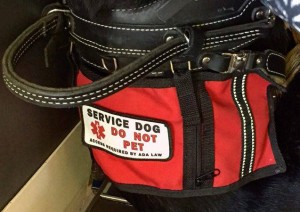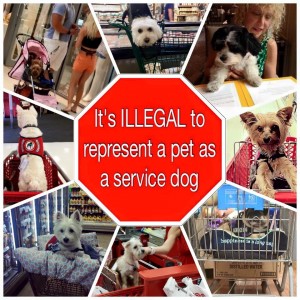Is It Really A Service Dog?
 In 2015, American Airlines made national headlines when employees denied a man access to the plane because of his service dog, even though the dog was wearing his harness and vest. This incident highlighted several issues faced by many service dog handlers, such as the lack of knowledge about service dogs and ADA laws, the rise in the number of fake service animals, and the general public’s misconceptions and misunderstandings surrounding legitimate service dogs. In this blog, we hope to clear up some of these misconceptions, and help the general public learn how to properly approach and treat service dogs.
In 2015, American Airlines made national headlines when employees denied a man access to the plane because of his service dog, even though the dog was wearing his harness and vest. This incident highlighted several issues faced by many service dog handlers, such as the lack of knowledge about service dogs and ADA laws, the rise in the number of fake service animals, and the general public’s misconceptions and misunderstandings surrounding legitimate service dogs. In this blog, we hope to clear up some of these misconceptions, and help the general public learn how to properly approach and treat service dogs.
What is A Service Dog?
A service dog has been specifically trained to provide assistance to an individual with a disability. A service dog is not just a pet that can be taken into public places; it is a legitimate working dog that performs specific tasks for its disabled handler to help mitigate their disability. While many service dogs tend to be medium- to large-sized breeds (particularly Labrador Retrievers, Golden Retrievers, and German Shepherds) a service dog can be any breed or mixed breed, any size, and either gender.
Disabilities Helped By Service Dogs
 A large variety of physical, mental, social, and emotional disabilities can be helped by a service dog; however, the general public is most familiar with seeing guide dogs for the blind or service animals for individuals in wheelchairs. But not all service dogs perform such highly-visible work; many work for handlers who do not have a visible disability, such as:
A large variety of physical, mental, social, and emotional disabilities can be helped by a service dog; however, the general public is most familiar with seeing guide dogs for the blind or service animals for individuals in wheelchairs. But not all service dogs perform such highly-visible work; many work for handlers who do not have a visible disability, such as:
- Diabetes, epilepsy, and other medical issues requiring alerts
- Vertigo
- Impaired mobility, hearing, or vision
- PTSD
- Autism
While there are dogs trained as authentic emotional support animals, an emotional support animal is not a true service dog and is not covered by the laws protecting service dogs and their handlers. A Psychiatric Service Dog, on the other hand, is a legitimate service dog that has been trained to support an individual whose disability happens to be due to mental illness. A dog for PTSD, for example, can be a Psychiatric Service Dog. Under the law, a business may not deny access to a PSD, but they can deny access to an animal whose sole task is to provide emotional assistance.
How Can You Tell if A Service Dog is Legitimate?
Under the Americans with Disabilities Act, it is illegal to ask a person to reveal their disability and to insist on identification of the animal. However, the following two questions can be asked if the animal’s service tasks are not obvious:
1. Is the dog required because of a disability?
2. What tasks has the dog been trained to perform?
Individuals with a trained service dog should be able to easily answer these questions. Additionally, there are other characteristics that are hallmarks of a legitimate service dog, such as:
- Being well-trained, well-behaved, of impeccable temperament, and under control. A barking, lunging, fearful, shy, rambunctious, or aggressive animal of poor temperament is not a service dog.
- Being on leash and free to perform its tasks for its handler, even if sitting on the lap of its handler. A dog stuffed in a purse, carried underneath an arm, roaming loose around the store, or placed in a shopping cart is not a service dog; a true service dog in these locations will be unable to perform their duties.
- Being obedient and unobtrusive. The dog sits and lays down on command, is quiet in the store or in the restaurant, does not approach other people or ask for petting, ignores other dogs, and is usually quite calm.
- Maintaining focus on the handler, not on other dogs, other people, or the interesting scents on the floor
 Fake Service Dogs
Fake Service Dogs
Attempting to falsely pass a dog off as a service dog is a crime punishable by fines and jail time. In addition to being illegal, such action also makes life more difficult for individuals who truly need a service dog. Fake service dogs ruin the reputation of legitimate service animals, make businesses and the general public much more skeptical of service dogs, and contribute to the discrimination against individuals with disabilities (particularly those that are not easily discerned or visible). Some businesses have even denied access to individuals with a legitimate service dog but without a visible disability, thinking the dog was a fake.
Unfortunately, there is no set national registration and certification process for service dogs. The lack of a registry combined with the proliferation of online stores that sell service dog vests and IDs to anyone with a credit card has made it easier to disguise a fake service dog. Most of these fake service dogs do not possess the necessary characteristics above, and in some cases can be a hazard to other patrons of the business. A true service dog is needed to help the handler function in daily life; a fake service dog is just a pet that the owner selfishly wants to bring with them wherever they go, breaking the law to do so.
 How to Interact with a Service Dog
How to Interact with a Service Dog
It is exceptionally important that people do not distract a service dog from its duties. It is equally important that parents teach their children that a service dog is a working dog that should not be pet or disturbed. The service dog is always working, even if he is just lying there next to the handler. Petting him, talking to him, allowing your own dog to “socialize” with him, or distracting him in any way will take his attention away from his handler. For a dog that is an alert dog, such as for epilepsy or low blood sugar, this temporary distraction can be enough to make him miss an alert, and this can result in the harm and hospitalization of their handler! So when you see a service dog:
- Do not pet the dog.
- Do not approach the dog with the intent of interacting with it.
- Do not attempt to draw the dog’s attention by making kissy noises, baby talk, or other “Here doggie!” noises.
- Do not let your children approach to pet or hug the dog.
- If you have a dog with you, do not let your dog interact with the service dog.
- Do not toss a toy or treat toward the dog in an attempt to engage it or ‘test its willpower.’
When you do see a service dog, be respectful of the dog and handler. If you have your own dog with you, then keep your dog close to you and under control. If you are a business owner and are skeptical of the dog, you may ask the handler the two questions listed above. Additionally, the dog should meet the general characteristics of a trained service dog mentioned earlier. By law a business may exclude a service dog if the dog is out of control, acting aggressively (and thus posing a threat to other patrons), or is not potty-trained. These are the only reasons a service dog may be excluded; simply doubting the dog’s legitimacy is not a valid reason.
How are Service Dogs Trained?
Service dogs can be trained by their handler, by a program or private trainer, or be obtained already trained from a program or private trainer. The dog must demonstrate the right genetic temperament for the work, and also must be socialized and trained carefully. It takes approximately two years to train a service animal, and training must be customized to the handler’s needs for their particular disability. The dog will need to have excellent obedience, good behavior in public settings, and mastery of the specific tasks that mitigate the handler’s disability.
We offer service dog training here at German Shepherd Watchdogs; please contact us if you are interested in training your dog for service work.

